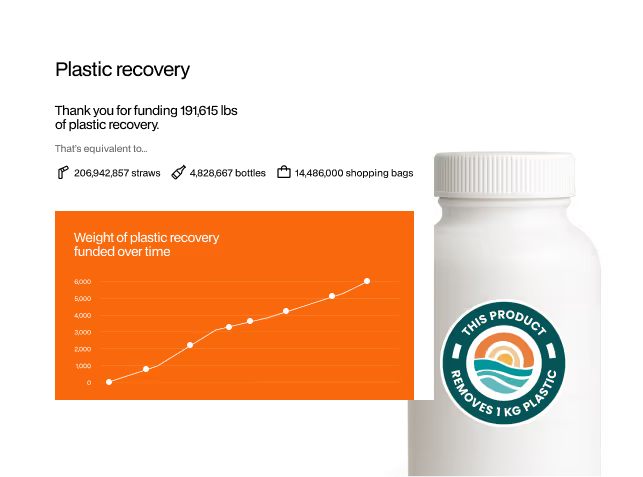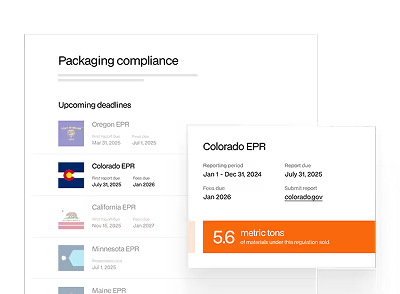We are living in a plastic pandemic. Plastic continues to be produced and used in quantities that just cannot be managed. Waste is ending up in the environment, and even plastic that is earmarked for recycling can end up being incinerated, exported, or dumped rather than turned back into something new.
As a result plastic waste is everywhere, and has become a top concern for customers around the world.
Brands are responding to this with plastic action strategies to reduce their contribution to the problem. While reduction and redesign efforts remain critical, one strategy is supporting plastic recovery projects to address the plastic being discarded today.
But is it really possible for a brand in North America or Europe to address the global plastic waste crisis by supporting a project elsewhere in the world? Can financing a project actually lead to quantifiable reductions in plastic pollution?
Here’s an introduction to how rePurpose Global connects finance from brands to verifiable action where it’s most needed, and how this leads to plastic recovery, socio-economic improvements, and environmental benefits.
We already have the solutions
Over 90 million metric tons of plastic leak into nature every year. Around half of this is openly burned, while the other half pollutes terrestrial and marine ecosystems. Unless there is a significant change, this number will increase to 239 million metric tons by 2040.
In other words, this pollution, already so visible and damaging in many parts of the world, is expected to more than double in that time.

Plastic pollution is one of the biggest environmental crises the planet faces today. It chokes ecosystems, poisons marine life, and has numerous negative consequences for human health and wellbeing.
In Systemiq’s Breaking the Plastic Wave report it is suggested that we already have the solutions to reduce the flow of plastic into the ocean by about 80% by 2040. There is no single solution that will solve the problem alone, but the solutions that form the mix are known. The report highlights that preventing plastic from entering the ocean requires a change in the way that we produce and use plastic. The report also shows that preventing ocean litter requires improvements to recycling practices, expanded waste collection services to billions who don’t yet have access, and other efforts to prevent plastic leakage.
New innovations and scientific breakthroughs may yet play a role in reducing plastic pollution, but with the solutions already available to turn the tide on plastic waste, it is the only the will of governments, businesses and individuals that currently prevents more decisive action.
rePurpose Global has a suite of solutions to fight plastic pollution that mirror the recommendations above. We support brands to measure and reduce plastic footprints, and find ways to reduce demand for virgin plastic.
Perhaps better known is that rePurpose Global enables verified plastic recovery through projects around the world that are fighting this escalating pollution crisis. Projects, primarily in the Global South are located in areas that are reeling with plastic pollution, due to mismanagement. It is in these areas that cost-effective interventions that fix value chains, and maximize the amount of pollution avoided per dollar, can make a huge difference.
Brands play a crucial role in funding this activity, and - as long as this doesn't detract from efforts to reduce their use of plastic - brands can receive product certifications that recognize this positive, voluntary, and immediate action.
Recovering additional plastic: making the economics work
rePurpose Global’s impact projects recover plastics that would not otherwise have been recovered. This is what we call 'additional' plastic: plastic would have been dumped, openly burned or potentially landfilled (i.e. polluted the environment) without our intervention.

But let’s break down what ‘financing the recovery of additional plastic’ really means.
No plastic needs to be openly burned, landfilled, or dumped. All plastic can be recycled or processed in ways that minimize pollution.
Whether or not this happens is usually dependent on someone being able to make a profit. If the cost of collecting and processing the waste is higher than the value of the material when it has been processed, it is unlikely to be collected. If the cost is lower than the end value, then it is likely to be collected.
For all plastic waste to go to end destinations that avoid pollution, we need to make the process economically viable. There are two ways that rePurpose Global recovery projects create the financial incentives to fight plastic pollution.
1 - Funding from brands builds infrastructure for plastic recovery.
Mitigating the plastic waste crisis requires strategic investments in infrastructure. There is, though, a huge funding gap. Indonesia alone estimated it would require $5.1 billion in capital investment before 2025, as well as an annual operating budget of $1.1 billion, to deliver on its commitments for a 70% reduction in the amount of plastic entering the ocean.
The plastic recovery process requires the following:
- the existence of waste collection and transportation services
- facilities where plastics are properly segregated
- further transportation of plastic from the sorting facility to the recycling or process facility, and
- recycling or processing facilities to exist.
At rePurpose Global, we work in areas where this process is not happening effectively – areas where plastic pollution is prevalent. In these areas we find the parts of this value chain that are broken. Our projects sponsor the establishment of a new infrastructure, or scaling up of an existing infrastructure, leading to additional plastic waste recovery.
The ability of our projects to do this depends on private sector capital – that is, money from brands that might be based on another continent. We ensure that the funding is channelled into systems and infrastructure that directly increases plastic recycling rates and reduces the total amount of plastic waste in nature.
For example, funding from brands to rePurpose Global's Saaf Samudra in Goa both ensured plastic waste collection, and directly supported the possibility of a new, mechanized, Material Recovery Facility (MRF). The new MRF enables the scaling up of plastic recovery volumes from a greater number of waste sources. As well as this, it further empowers more project waste workers who are provided with safety and protective equipment, fair and steady monthly payments and measurably improved income streams.

2 - Finance is used to create a financial incentive for collection of low-value plastics
Soft and multi-layered plastics (MLP) such as single-use plastic bags, toffee wrappers, and chip packets are not collected in many parts of the world. They are usually ignored by waste pickers because there is no secondary market for these materials - they are not recyclable.
As these plastics are lightweight, when they are landfilled and dumped, these soft plastics are more likely to get carried away by heavy winds or water. These plastics, more than any others, are polluting our rivers, forests, and oceans.
There are more environmentally appropriate end destinations available for low-value plastics. Solutions that avoid polluting the environment:
- Where the technology is available, these plastics can be upcycled into eco-wood - this is what happens at rePurpose Global project Nuevo Ciclo in Medellín, Colombia.
- MLP can also be co-processed as part of cement manufacture (where - unlike open burning - high temperatures allow lightweight plastics to be effectively disposed of without harmful emissions).
Both of these processes give plastic waste some value, but this value is still - typically - far lower than the cost of sorting, baling, transporting, and processing. So this is another area where brands can have a direct impact. Their funding is used to overcome this cost gap. rePurpose Global’s brand partners ensure there are financial incentives for the collection of low value plastics, that there is payment for the segregation and processing to happen, and that plastic is transported to a suitable ‘end destination’ rather than polluting the air, water, and land.
rePurpose Global’s project Fann Epo, in Accra, Ghana, provides a good case study for this. Our principle of fixing the waste value chain be applied beyond low-value plastics and MLP. For example, PET (the plastic typically used for drinks bottles) does not have any collection value in Ghana. With a lack of recycling infrastructure locally, there is no market for PET.
rePurpose Fann Epo steps in here, and subsidizes the collection of PET plastic bottles, as well as associated transportation costs. This increases the earning potential of local waste collectors. On top of this, the higher processing volumes of PET will go some way to incentivizing a first-of-its-kind bottle to bottle recycling facility in Ghana. Until then, the collected plastic is exported for recycling and creates PET recyclate that can be used in place of virgin plastics – further reducing the risk of plastic waste and pollution.
Plastic recovery supports circularity
Funding plastic recovery can also drive circularity. As in the Ghana example above, brand funding can contribute to increased recycling rates of plastics. In turn, the availability and use of recycled plastic can help to reduce demand for virgin plastic. Prices for recycled polyethylene terephthalate (rPET) have been climbing in the last year or so, which has hindered consistent adoption, and contributing to the increased supply and a more stable price is critical to the adoption of recycled plastic.
Of course, recycling and end-of-life management is only a part of the solution to the plastic waste crisis. We also need to fundamentally rethink the way we make, use, and reuse plastics so that they don’t become waste in the first place. At rePurpose, brands that are investing in plastic recovery as part of certification scheme must be committed to reduction and redesign measures that increase the circularity of their products or packaging (e.g. replacing plastic packaging or changing to plastic polymers that are more widely compatible with recycling infrastructure and equipment).
Do no harm
It is obviously important that our work recovering plastic also limits any adverse side-effects that could cause environmental damage and undermine some of these benefits.
At a basic level, all of our impact projects comply with existing legislation and regulations regarding pollution and the protection of the environment. This includes maintaining the relevant permits and NOCs (No Objection Certificates) from local authorities and pollution control boards, and these certificates must also be maintained by all end-destination waste processing facilities (recycling centers or co-processing plants).
We also mandate that projects do not infringe on any protected areas or vulnerable ecosystems, and we work with projects to find sustainable transport solutions – both for workers and for waste.
But we are working with our projects to go further than minimum legal requirements. For example, we work with some of our projects sites to submit energy use records, and to create plans to reduce carbon emissions. We also have protocols around transportation to reduce the number of journeys required (e.g. compressing of plastic waste for transport efficiency). If any organic waste is present in the waste collection stream, our impact partners will explore composting options.

There is also a community element to this. When establishing a new project we work with impact partners and local communities to ensure appropriate permissions, provisions, and stakeholder consultations are considered. All of our projects are formulated to help foster social and economic development and contribute to the sustainability of the communities in which they operate.
Final Thoughts
Financing plastic recovery projects can be a powerful environmental action for brands. Brand funding helps to reduce plastic pollution by:
- building infrastructure that will help to tackle pollution and support recycling for years to come;
- fixing waste management value chains - including bringing waste management services to those who previously had no access;
- incentivizing the collection and processing of polluting low-value plastics; and
- supporting the increased circularity of some plastic polymers.
Working on plastic recovery projects with rePurpose Global goes even further. We provide robust additionality on plastic recovery (so guaranteeing that the projects are only counting plastic recovery over and above ‘business as usual’), have fully verifiable and audited impact data, and include further environmental and social safeguards and support.
Brands that are voluntarily funding this positive environmental and social action, on top of their own work to reduce plastic use, certainly deserve some plaudits. Brands really can take a stand against plastic pollution, and make a quantifiable difference.
-

.avif)
.png)
.avif)
.png)
.avif)






